
The cuisine of Germany is made up of many different local or regional cuisines, reflecting the country's federal history. Germany itself is part of the larger cultural region of Central Europe, sharing many culinary traditions with neighbouring countries such as Poland and the Czech Republic. Southern regions, like Bavaria and Swabia, share dishes with Austrian cuisine and parts of Swiss cuisine.

Sauerkraut is finely cut raw cabbage that has been fermented by various lactic acid bacteria. It has a long shelf life and a distinctive sour flavor, both of which result from the lactic acid formed when the bacteria ferment the sugars in the cabbage leaves. It is one of the best-known national dishes in Germany.
Kraut is a German word recorded in English from 1918 onwards as an ethnic slur for a German, particularly a German soldier during World War I and World War II. Its earlier meaning in English was as a synonym for sauerkraut, a traditional Central and Eastern European food.
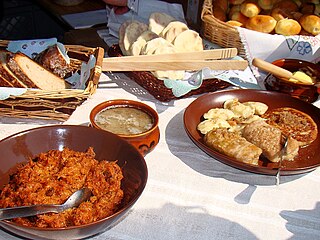
Polish cuisine is a style of cooking and food preparation originating in or widely popular in Poland. Due to Poland's history, Polish cuisine has evolved over the centuries to be very eclectic, and it shares many similarities with other regional cuisines. Polish-styled cooking in other cultures is often referred to as à la polonaise.
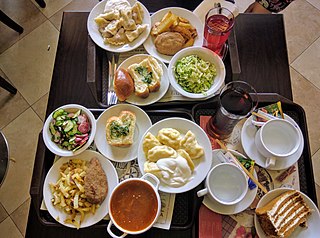
Ukrainian cuisine is the collection of the various cooking traditions of the people of Ukraine, one of the largest and most populous European countries. It is heavily influenced by the rich dark soil (chernozem) from which its ingredients come and often involves many components. Traditional Ukrainian dishes often experience a complex heating process – "at first they are fried or boiled, and then stewed or baked. This is the most distinctive feature of Ukrainian cuisine".

A frikadelle is a rounded, flat-bottomed, pan-fried meatball of minced meat, often likened to the German and/or Danish version of meatballs. The origin of the dish is unknown. The term frikadelle is German but the dish is associated with both German, Scandinavian and Polish cuisines. It is considered a national dish in Denmark. They are one of the most popular meals in Poland, where they are known as kotlety mielone. In Norway, the dish is known as kjøttkaker, and in Sweden as pannbiff.

A cabbage roll is a dish consisting of cooked cabbage leaves wrapped around a variety of fillings. It is common to the cuisines of Central, Northern, Eastern and Southeastern Europe and much of Western Asia, Northern China, as well as parts of North Africa. Meat fillings are traditional in Europe, and include beef, lamb, or pork seasoned with garlic, onion, and spices. Grains such as rice and barley, mushrooms, and vegetables are often included as well. Fermented cabbage leaves are used for wrapping, particularly in southeastern Europe. In Asia, seafoods, tofu, and shiitake mushrooms may also be used. Chinese cabbage is often used as a wrapping.

Peasant foods are dishes eaten by peasants, made from accessible and inexpensive ingredients.
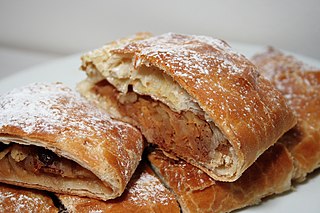
A strudel is a type of layered pastry with a filling that is usually sweet, but savoury fillings are also common. It became popular in the 18th century throughout the Habsburg Empire. Strudel is part of Austrian cuisine but is also common in other Central European cuisines. In Italy it is recognized as a traditional agri-food product (PAT) of South Tyrol.

Bierock is a yeast dough pastry pocket sandwich with savory filling, originating in Prussia. The dish is common among the Volga German community in the United States and Argentina. It was brought to the United States in the 1870s by German Russian Mennonite immigrants. It has developed strong cultural associations with the cuisine of the Midwestern United States.
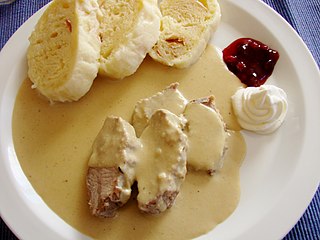
Czech cuisine has both influenced and been influenced by the cuisines of surrounding countries and nations. Many of the cakes and pastries that are popular in Central Europe originated within the Czech lands. Contemporary Czech cuisine is more meat-based than in previous periods; the current abundance of farmable meat has enriched its presence in regional cuisine. Traditionally, meat has been reserved for once-weekly consumption, typically on weekends.

Schweinshaxe, in German cuisine, is a roasted ham hock. The ham hock is the end of the pig's leg, just above the ankle and below the meaty ham portion. It is especially popular in Bavaria as Schweinshaxn [ˈʃvaɪns.haksn̩] or Sauhax(n) [ˈsaohaks(n̩)]. A variation of this dish is known in parts of Germany as Eisbein, in which the ham hock is pickled and usually slightly boiled.
Macedonian cuisine is the cuisine of the region of Macedonia in northern Greece. Contemporary Greek Macedonian cooking shares much with general Greek and wider Balkan and Mediterranean cuisine, including dishes from the Ottoman past. Specific influences include dishes of the Anatolian Greek, Aromanian and Megleno-Romanian, Slavic, Armenian and Sephardi Jewish population. The mix of the different people inhabiting the region gave the name to the Macedonian salad.

Schupfnudel, also called Fingernudel, is a type of dumpling or thick noodle in southern German and Austrian cuisine. It is similar to the Central European kopytka. They take various forms and can be referred to with a variety of names in different regions. They are usually made from rye or wheat flour and egg. Since the introduction of the potato to Germany in the seventeenth century, Schupfnudeln have also been made with potatoes. They are traditionally given their distinctive ovoid shape through hand-shaping. They are often served as a savory dish with sauerkraut but are also served in sweet dishes.

Bavarian cuisine is a style of cooking from Bavaria, Germany. Bavarian cuisine includes many meat and Knödel dishes, and often uses flour. Due to its rural conditions and cold climate, only crops such as beets and potatoes do well in Bavaria, being a staple in the German diet.

Pichelsteiner is a German stew that contains several kinds of meat and vegetables.

Flæskesteg, ['flɛːskə.stɐ̯j] the Danish version of roast pork, is considered to be one of Denmark's principal national dishes. Always prepared with crackling, it is also a favourite for the Danish Christmas dinner served as the evening meal on 24 December or Christmas Eve.

Franconian cuisine is an umbrella term for all dishes with a specific regional identity belonging to the region of Franconia. It is a subtype of German cuisine with many similarities to Bavarian cuisine and Swabian cuisine. It is often included in the Bavarian cuisine, since most parts of Franconia belong to Bavaria today. There are several Franconian food items that are also famous beyond the borders of Franconia, such as Nürnberger Lebkuchen, Bratwurst and the wines of Franconia. Franconia is also famous for its beer and harbours the highest density of breweries in the world.
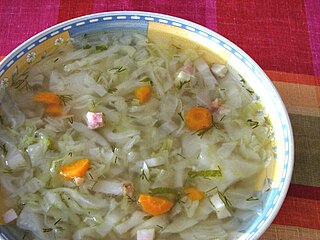
Cabbage soup may refer to any of the variety of soups based on various cabbages, or on sauerkraut and known under different names in national cuisines. Often it is a vegetable soup. It may be prepared with different ingredients. Vegetarian cabbage soup may use mushroom stock. Another variety is using a fish stock. Traditional cabbage soup is prepared using a pork stock.

















